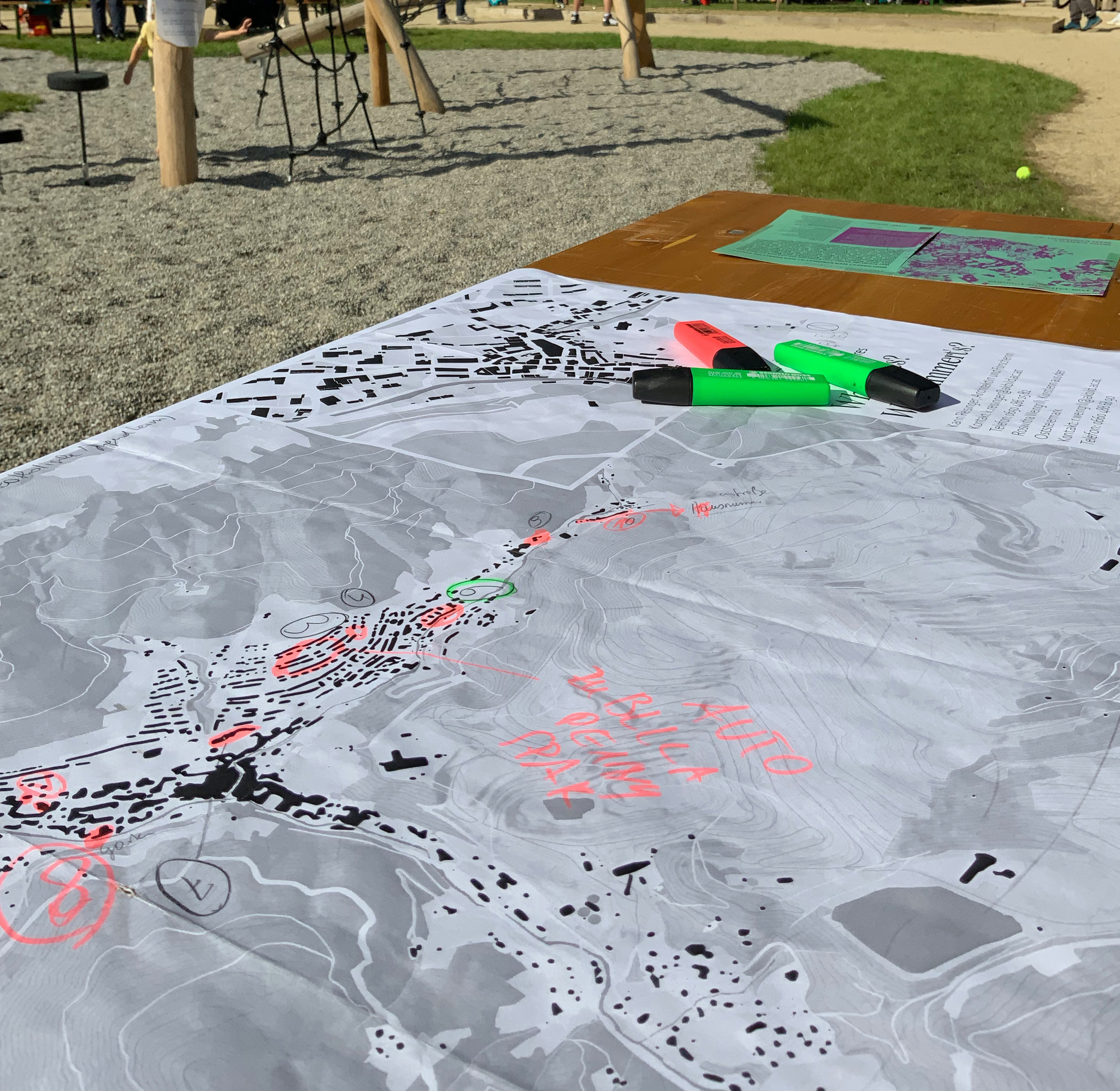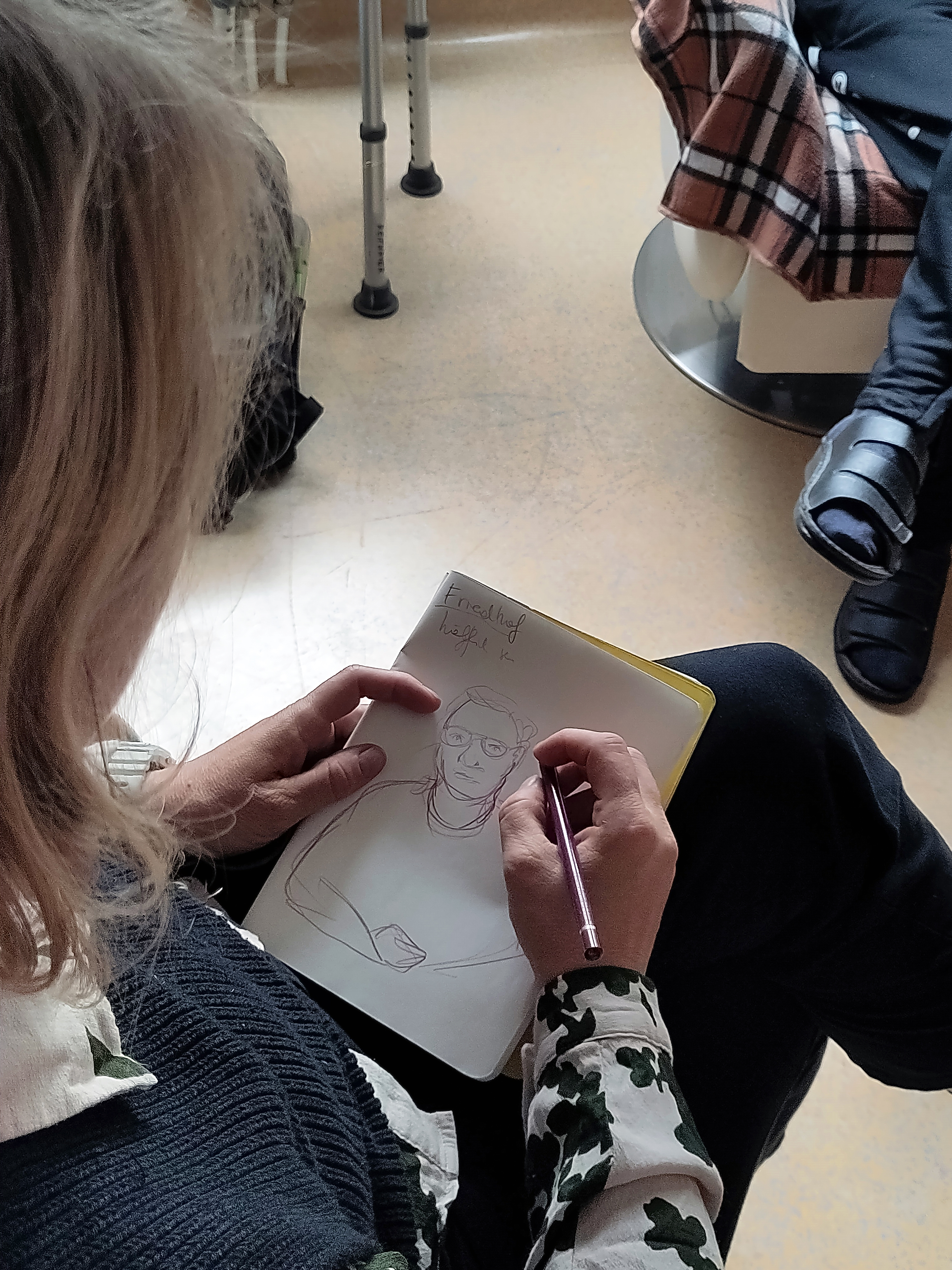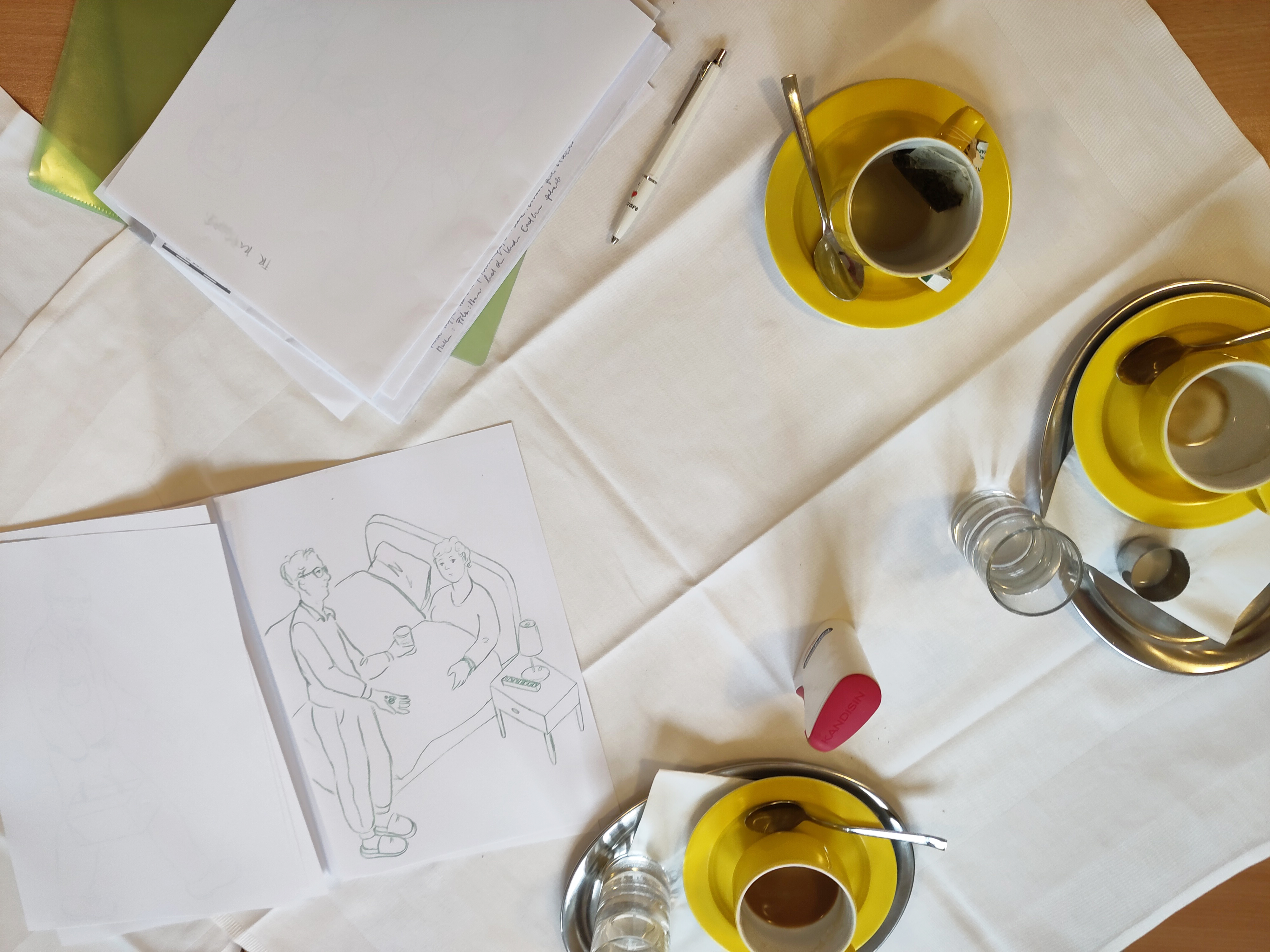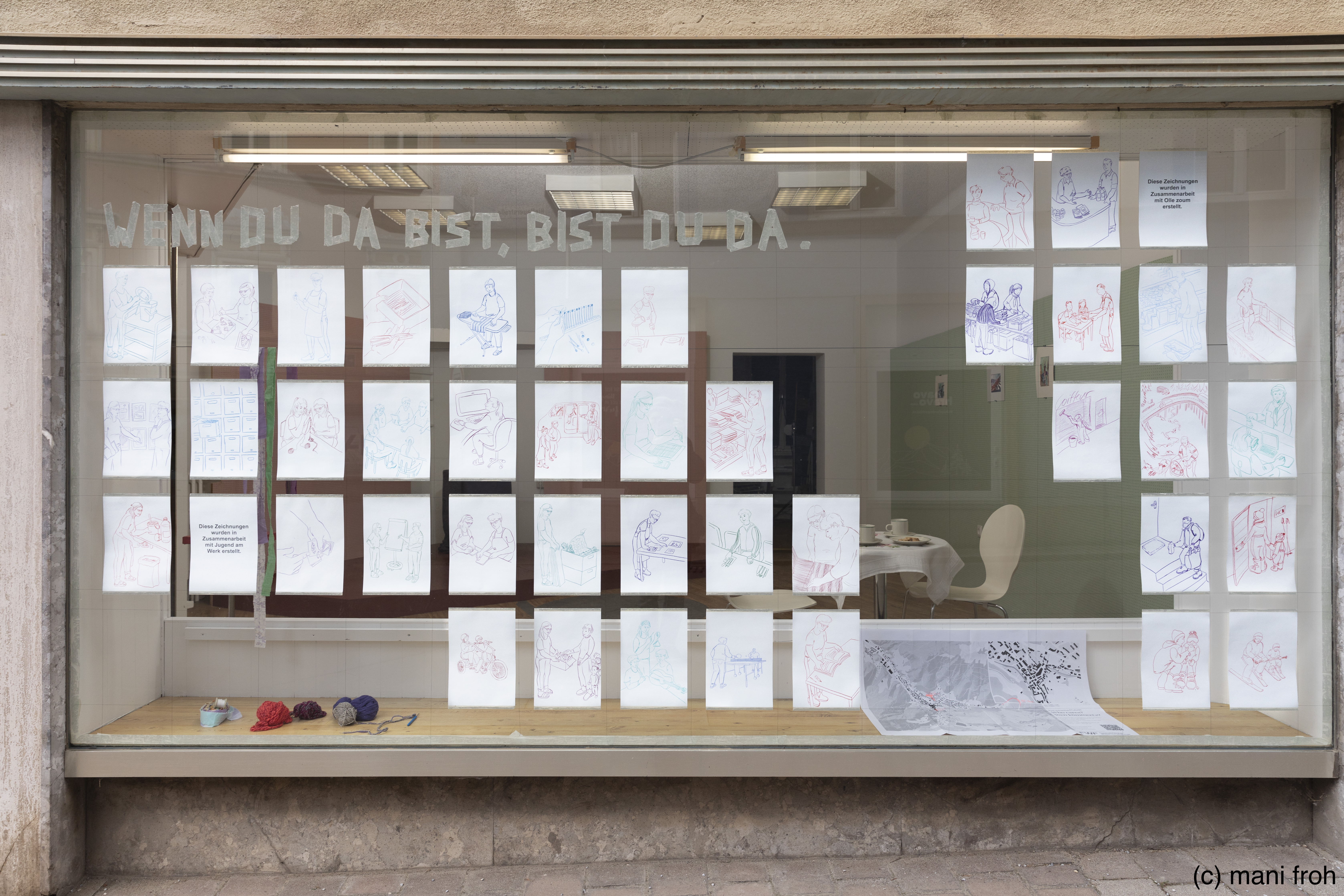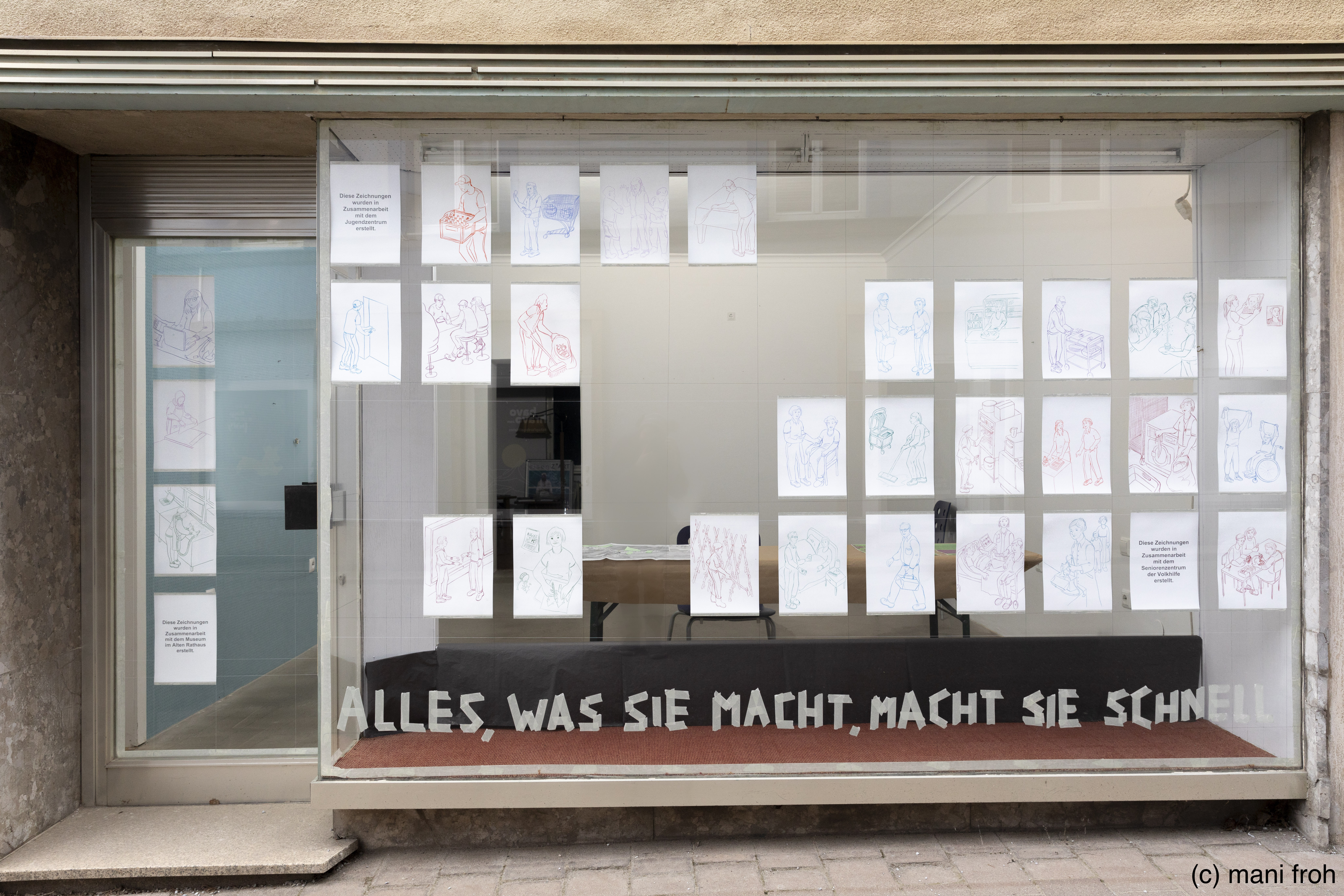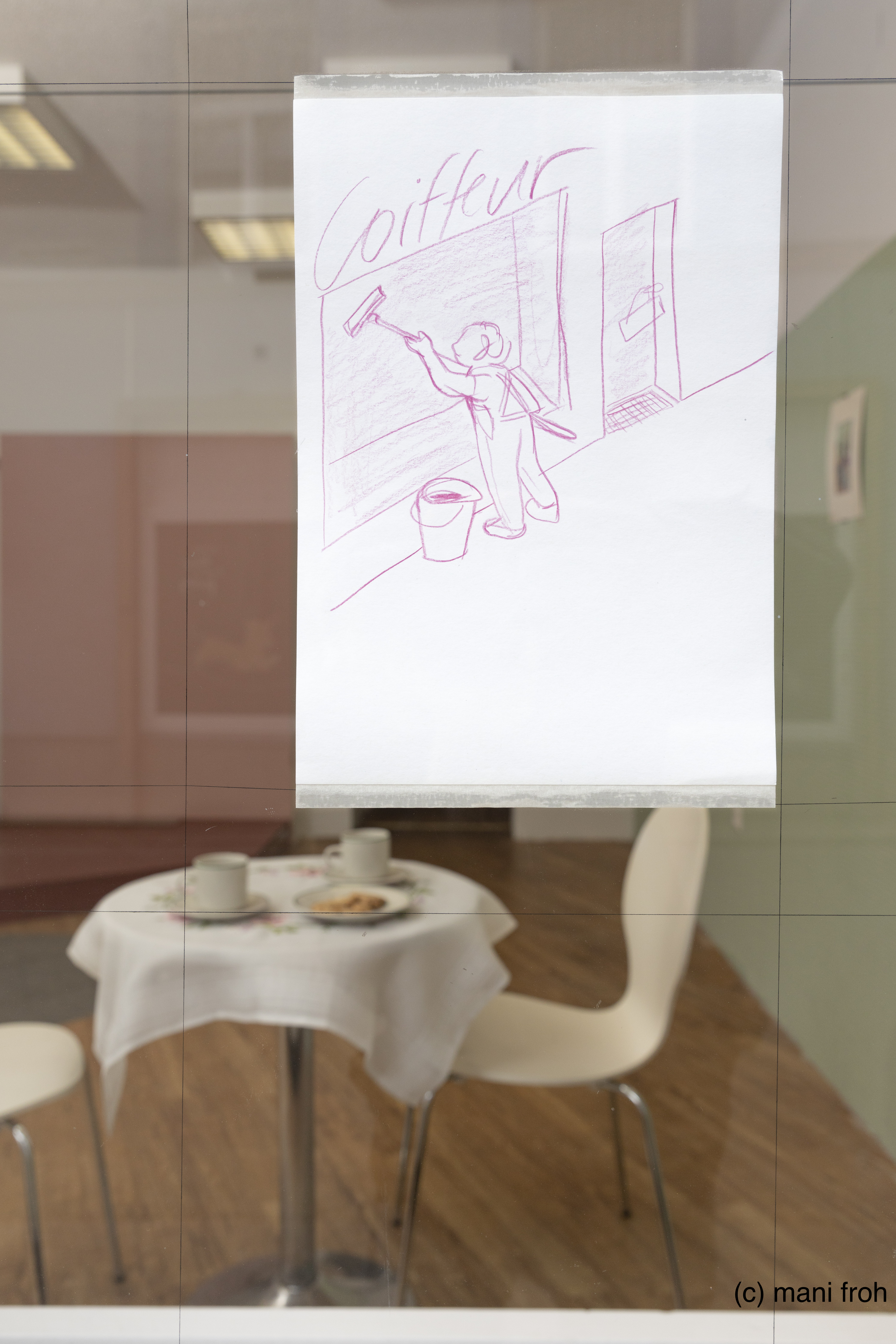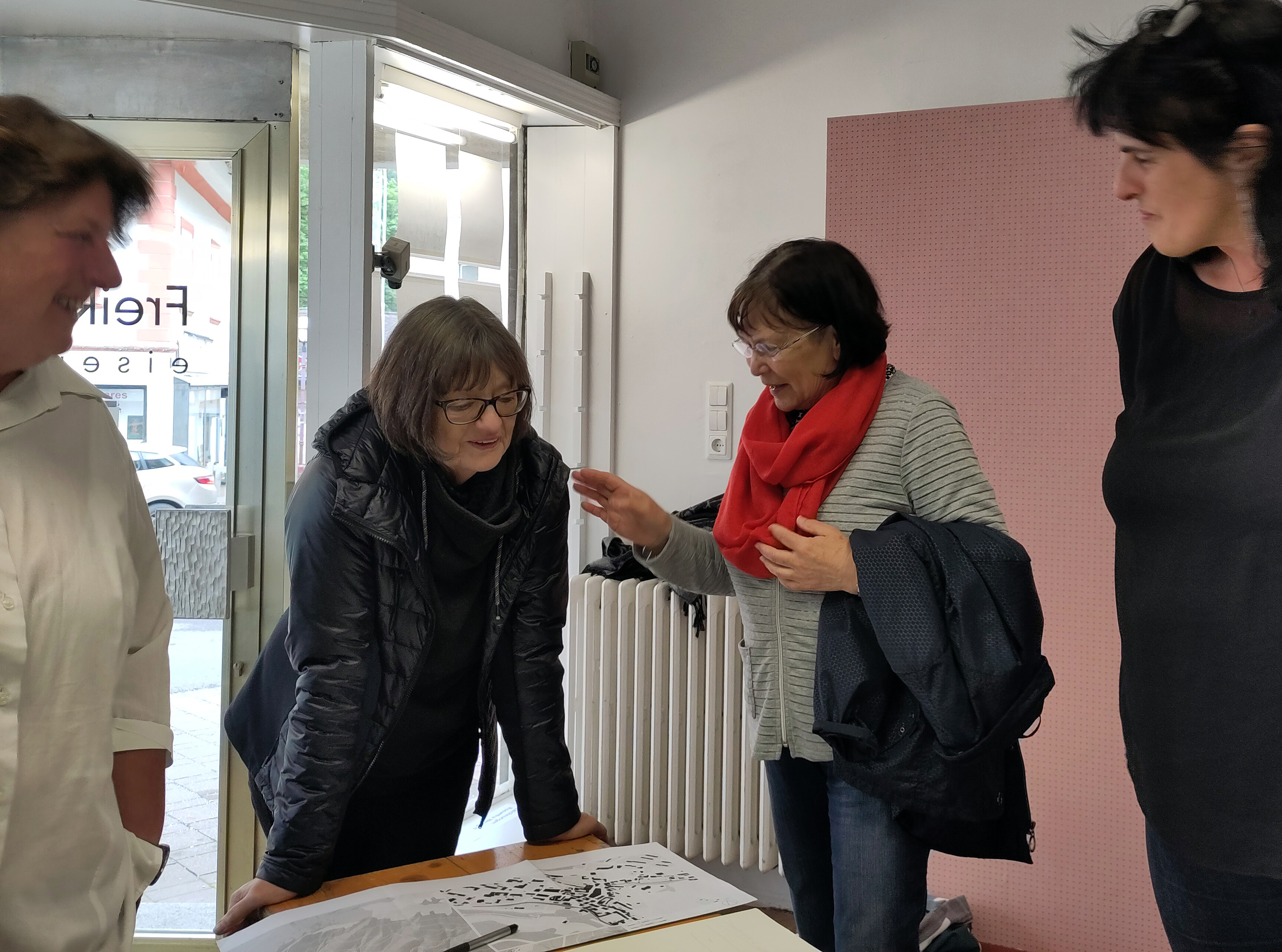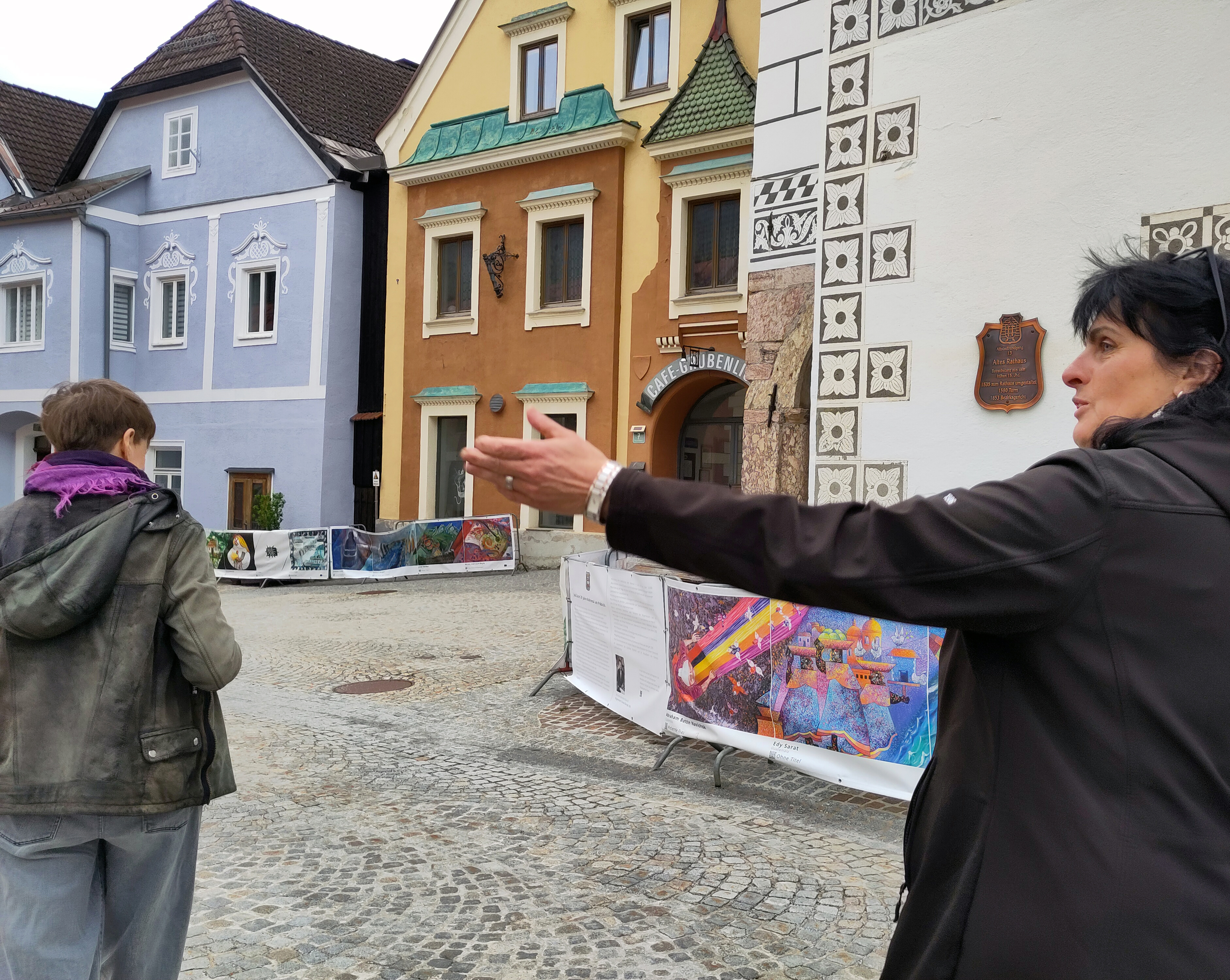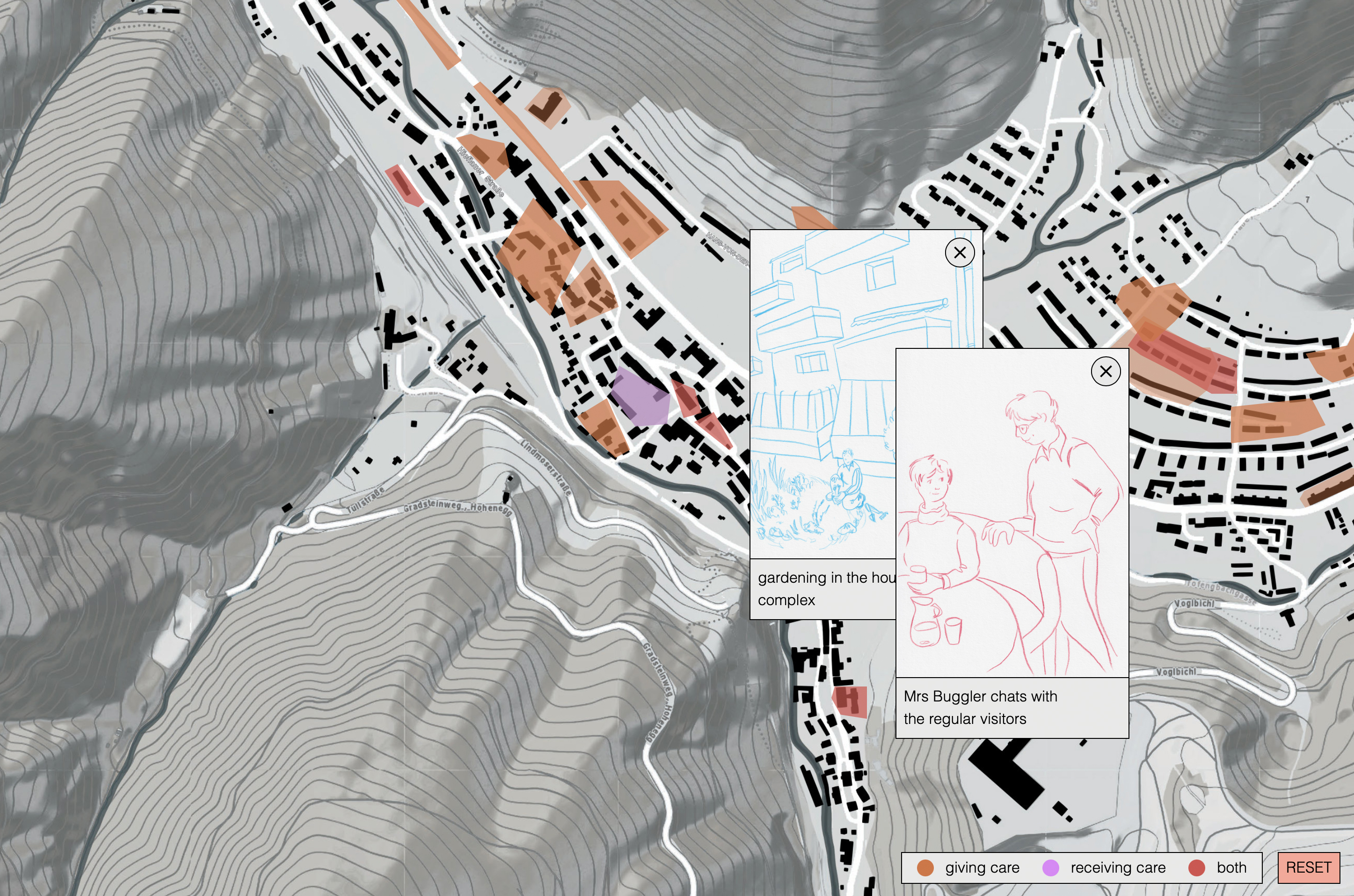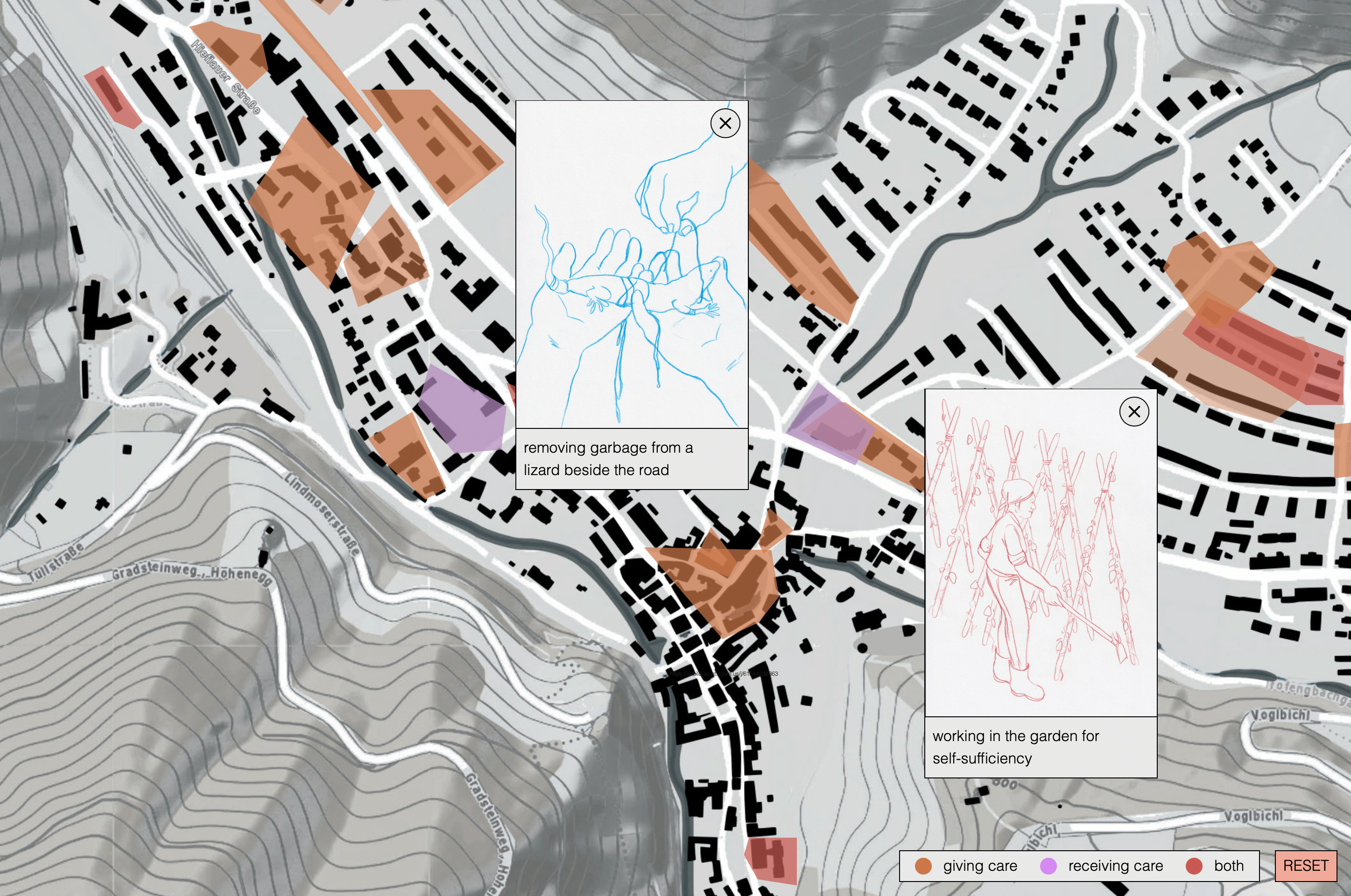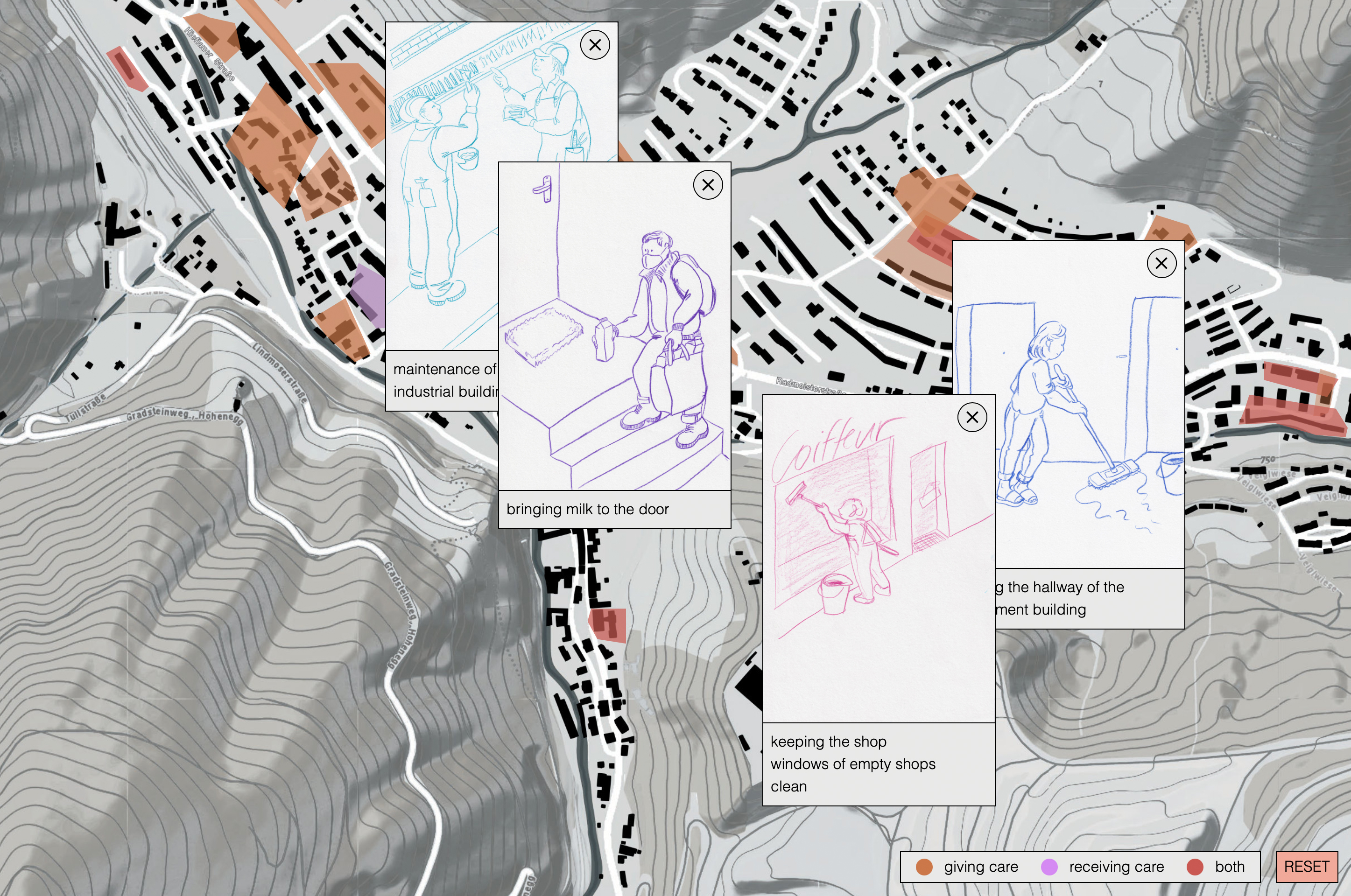Prioritising the places and people that need it the most
Post-extractive F*utures
Stories of Post-extractive F*utures to Shift Perspectives in Post-industrial Areas
The post-industrial, shrinking town of Eisenerz is experiencing a rural exodus, which affects women in particular. This project gathered local practices of care, reproduction and maintenance, which are often overlooked amid heroic narratives of ore mining. Working with locals, mostly women, many of them retirees and among them a group with dis_abilities, the project collated diverse spatial practices of local care to articulate their role in future scenarios for the crisis-torn town.
Austria
Local
the town of Eisenerz, Austria
Mainly rural
It refers to other types of transformations (soft investment)
Yes
2024-10-31
Yes
Top Citizen Science Fund of Austrian Science Funds (FWF), project no. TCS128
No
No
As an individual
The population of the mountain town Eisenerz has shrunk from over 12,000 people to less than 4,000, since mining requires an ever-smaller human workforce. The result is a town with many abandoned buildings and the highest average age in Austria. Its infrastructure is hard to maintain financially. With the help of its citizens, we collated stories of care to create a shared imaginary for the future of the town that allows resilient and dynamic assemblages post-exploitation.
We worked with people who take care of their town – they work in the library, clean windows of abandoned shops, take care of the elderly population or create places for the community to come together and learn from one another. Much of this work is unpaid and done by women, often during their retirement. People with dis_abilities play active roles in maintaining the community. With these people, we collated care practices and transformed them into drawings, exhibited them in the town and discussed them during events to reflect on the town’s future.
On the one hand, we worked on understanding how care can be the starting point for future scenarios of a town in crisis; and, on the other hand, we assembled care practices and care takers, strengthened their roles in the town and contributed to their self-reflection and self-awareness. An important aspect was the collaboration with women with dis_abilities (Jugend am Werk) and their knowledge of resilience and care. Bringing these groups together, also with young people, to work on future imaginaries of the town was a core objective, grounded in an intersectional gender approach.
Outcomes were 108 drawings of care practices, an exhibition that revived the centre of the town and an interactive online map, a radio broadcast and further dissemination. However, equally crucial were processes of sharing knowledge and group building across generations and abilities – important features for learning about sustainable futures in times of cris
We worked with people who take care of their town – they work in the library, clean windows of abandoned shops, take care of the elderly population or create places for the community to come together and learn from one another. Much of this work is unpaid and done by women, often during their retirement. People with dis_abilities play active roles in maintaining the community. With these people, we collated care practices and transformed them into drawings, exhibited them in the town and discussed them during events to reflect on the town’s future.
On the one hand, we worked on understanding how care can be the starting point for future scenarios of a town in crisis; and, on the other hand, we assembled care practices and care takers, strengthened their roles in the town and contributed to their self-reflection and self-awareness. An important aspect was the collaboration with women with dis_abilities (Jugend am Werk) and their knowledge of resilience and care. Bringing these groups together, also with young people, to work on future imaginaries of the town was a core objective, grounded in an intersectional gender approach.
Outcomes were 108 drawings of care practices, an exhibition that revived the centre of the town and an interactive online map, a radio broadcast and further dissemination. However, equally crucial were processes of sharing knowledge and group building across generations and abilities – important features for learning about sustainable futures in times of cris
gender imbalances in post-industrial areas
future imaginaries
care and voluntary work
abandonment / shrinking
overaging and dis_ability
The project’s imaginary for the future scenario of the mining town in crisis is made up of stories that centre on the revitalisation and reuse of abandoned buildings, the town centre and infrastructures for community, and on the maintenance of the social infrastructure. The results identified buildings and parts of the town in which care activities take place and maintain the community (https://www.mountains-of-ore.org/en/pef/map/). We contributed an alternative aspect, based on care, maintenance and gender, to the town planning, maintenance and preservation of the historic buildings, which date back to the 16th century. Celebrating diverse care activities and making them approachable for sustainable future scenarios of the town and emphasising the agency of carers, the project also updated outdated gender principles, which rely on industrial gender stereotypes.
Part of the project involved showing and discussing the results in the community via an exhibition to negotiate care practices onsite and empower the manifold structures of care. We were able to revive a central place in the town through an exhibition in the local FreiRaum gallery and other events (https://www.mountains-of-ore.org/en/pef/events/), including a “future workshop” run by Manuela Zechner, an expert on care theories and feminist political ecologies (https://thefuturearchiveblog.wordpress.com/2024/07/01/post-extractive-futures/). The project innovatively connected issues of gender and regeneration based on existing structures, practices and literacies, and on intergenerational and circular thinking for the longevity of the community.
Part of the project involved showing and discussing the results in the community via an exhibition to negotiate care practices onsite and empower the manifold structures of care. We were able to revive a central place in the town through an exhibition in the local FreiRaum gallery and other events (https://www.mountains-of-ore.org/en/pef/events/), including a “future workshop” run by Manuela Zechner, an expert on care theories and feminist political ecologies (https://thefuturearchiveblog.wordpress.com/2024/07/01/post-extractive-futures/). The project innovatively connected issues of gender and regeneration based on existing structures, practices and literacies, and on intergenerational and circular thinking for the longevity of the community.
The project foregrounded collaborative qualities of places, building future scenarios on complex social interactions of care structures. It strengthened the ties between crucial parts of the town and its citizens, especially women, appreciating and celebrating small-scale spatial practices of care and bringing them together in collated imaginaries for future scenarios. Values of collaboration and estimation of voluntary care work were central to the project.
Artist Roswitha Weingrill brought cultural values to the project by transforming daily stories of care into 108 drawings (https://repository.akbild.ac.at/de/alle_inhalte/query;fq=%7B%22fulltext%22:%5B%22weingrill%22%5D%7D;st=0;sz=50/28288), which were handed over to the citizens after being exhibited in the local FreiRaum gallery. During this time, the project results were accessible in the town centre and accompanied by events and discussions, which included all citizens from/in the town.
Acknowledging the generous contribution of people with dis_abilities was key, and their skilled contributions to the local community were represented among the collated stories. Since the exhibition, which showed their practices of care, the drawings have become a permanent exhibition in their workshop.
Together with the local citizens, mostly women, we practised literacies in mapping and drawing for planning and assembling. An interactive map (https://www.mountains-of-ore.org/en/pef/map/) shows the activities online and makes them a discussion point for the general public, the municipality of Eisenerz and people otherwise related to Eisenerz.
These combined interventions contributed to the sense of belonging, showing a rich complexity of sophisticated local activities, which increased the acknowledgement and self-awareness of the carers for their town.
Artist Roswitha Weingrill brought cultural values to the project by transforming daily stories of care into 108 drawings (https://repository.akbild.ac.at/de/alle_inhalte/query;fq=%7B%22fulltext%22:%5B%22weingrill%22%5D%7D;st=0;sz=50/28288), which were handed over to the citizens after being exhibited in the local FreiRaum gallery. During this time, the project results were accessible in the town centre and accompanied by events and discussions, which included all citizens from/in the town.
Acknowledging the generous contribution of people with dis_abilities was key, and their skilled contributions to the local community were represented among the collated stories. Since the exhibition, which showed their practices of care, the drawings have become a permanent exhibition in their workshop.
Together with the local citizens, mostly women, we practised literacies in mapping and drawing for planning and assembling. An interactive map (https://www.mountains-of-ore.org/en/pef/map/) shows the activities online and makes them a discussion point for the general public, the municipality of Eisenerz and people otherwise related to Eisenerz.
These combined interventions contributed to the sense of belonging, showing a rich complexity of sophisticated local activities, which increased the acknowledgement and self-awareness of the carers for their town.
The project builds on intersectional gender, foregrounding the care work of women, intergenerational connections, and the urban knowledge and literacies of people with dis_abilities. It showed practices of care amid extraction – a large part done by retired women. An ethical, intersectional framework of feminist citizen science contributed to delivering a complex, yet profound, future imaginary. To reach this goal through diverse contributions, we worked with local associations/groups and individuals:
- Jugend am Werk, a workshop for women with dis_abilities
- Olle zoum, a local initiative with an affordable meeting space and a flea market
- The local retirement home
- The youth centre, which is run on a voluntary basis
- MIMO, an indoor mini-golf space that is used for gatherings of a local umbrella association (Vereinsgemeinschaft)
- The local museum (Museum im Alten Rathaus)
Thus, the project assembled a variety of actors that represented young people and also retired people taking care of the community, for example working voluntarily in the library, cleaning and designing windows of empty shops or renovating heritage-protected buildings. The collaboration with Jugend am Werk, a workshop for women with dis_abilities, was pivotal. The women’s stories were crucial for understanding their urban knowledge and their practices of care for the community. Together with them, we opened the “City of Care” exhibition in Eisenerz. This and other events offered opportunities for social interaction between generations and abilities.
All project events were open to all, food was provided and the onsite and online dissemination guaranteed access to everybody. The project is exemplary in building on a complex intersectional gender approach in an area known for heroic mining narratives. It brought the knowledges of women in their retirement, women with dis_abilities and paid and unpaid carers together to creatively formulate potentials for future scenarios.
- Jugend am Werk, a workshop for women with dis_abilities
- Olle zoum, a local initiative with an affordable meeting space and a flea market
- The local retirement home
- The youth centre, which is run on a voluntary basis
- MIMO, an indoor mini-golf space that is used for gatherings of a local umbrella association (Vereinsgemeinschaft)
- The local museum (Museum im Alten Rathaus)
Thus, the project assembled a variety of actors that represented young people and also retired people taking care of the community, for example working voluntarily in the library, cleaning and designing windows of empty shops or renovating heritage-protected buildings. The collaboration with Jugend am Werk, a workshop for women with dis_abilities, was pivotal. The women’s stories were crucial for understanding their urban knowledge and their practices of care for the community. Together with them, we opened the “City of Care” exhibition in Eisenerz. This and other events offered opportunities for social interaction between generations and abilities.
All project events were open to all, food was provided and the onsite and online dissemination guaranteed access to everybody. The project is exemplary in building on a complex intersectional gender approach in an area known for heroic mining narratives. It brought the knowledges of women in their retirement, women with dis_abilities and paid and unpaid carers together to creatively formulate potentials for future scenarios.
- Local citizens, mostly women, shared and located stories of care practices, which form the core of the project. Some citizens even researched private archives.
- The process of transforming the citizens’ stories into drawings by artist Roswitha Weingrill: all drawings were evaluated by the citizens and amended according to their inputs.
- Processes of mutual learning took place in meetings and shared activities. Many groups offered their spaces for the meetings.
- Based on collaborative science and an affirmative and inclusive approach, citizens were involved in decision-making on many levels, co-designing the gender strategy of the project and offering ongoing feedback. A prolonged initial project phase ensured the project design was attuned to the needs of the citizens and community.
Special contributions of groups:
1) The ambitious local initiative Olle zoum (Renate Buggler) organised a gathering for us to bring pensioners and different classes to the decision-making table and centre their stories.
2) The final future workshop assembled practices and ideas for Eisenerz. Citizens contributed actively.
3) The group Jugend am Werk contributed most of the stories, showing that we cannot always differentiate between who is taken care of and who is the carer. They became a central part of the exhibition; and Sabine Üblein, equipped with great rhetorical skills, opened the exhibition with a speech and a tour. It was key to make the voices of people with dis_abilities heard in a final radio show called “Who Cares?”, a collaboration with radio dérive (https://derive.at/radio/who-cares/).
4) Many participants contributed to sharing the project, including the radio broadcast and a co-authored publication, which will be published in 2025 (TU Vienna).
The contributions broadened imaginations for future scenarios. To reach this degree of participation, a long phase of research, participatory observation and trust-building was necessary.
- The process of transforming the citizens’ stories into drawings by artist Roswitha Weingrill: all drawings were evaluated by the citizens and amended according to their inputs.
- Processes of mutual learning took place in meetings and shared activities. Many groups offered their spaces for the meetings.
- Based on collaborative science and an affirmative and inclusive approach, citizens were involved in decision-making on many levels, co-designing the gender strategy of the project and offering ongoing feedback. A prolonged initial project phase ensured the project design was attuned to the needs of the citizens and community.
Special contributions of groups:
1) The ambitious local initiative Olle zoum (Renate Buggler) organised a gathering for us to bring pensioners and different classes to the decision-making table and centre their stories.
2) The final future workshop assembled practices and ideas for Eisenerz. Citizens contributed actively.
3) The group Jugend am Werk contributed most of the stories, showing that we cannot always differentiate between who is taken care of and who is the carer. They became a central part of the exhibition; and Sabine Üblein, equipped with great rhetorical skills, opened the exhibition with a speech and a tour. It was key to make the voices of people with dis_abilities heard in a final radio show called “Who Cares?”, a collaboration with radio dérive (https://derive.at/radio/who-cares/).
4) Many participants contributed to sharing the project, including the radio broadcast and a co-authored publication, which will be published in 2025 (TU Vienna).
The contributions broadened imaginations for future scenarios. To reach this degree of participation, a long phase of research, participatory observation and trust-building was necessary.
Municipality: The municipality of Eisenerz, represented by Bianca Pehn, supported the project through all its stages. This engagement, and the presence of the mayor during events, were crucial for ensuring sustainable knowledge transfer into the community and its ongoing relevance. The project was also presented in three articles in the local magazine.
Citizens: Different scales were important for the project, with the base formed through a high number of small sales of engagement in a rigid bottom-up scheme for future imaginaries. Thus, we worked with different local associations of the town to collate scenarios based on what is already there to avoid abstract concepts from outside. These associations were Olle zoum, a local initiative with an affordable meeting space and a flea market, the local retirement home, the youth centre, MIMO, an indoor mini-golf space also used for gatherings, and the local museum. We worked with the organisational leaders, as well as individual members of the groups, to go deep into the structures of care work. Thus, the project left many single traces of estimation and reflections of care work.
Iron Women: On a broader regional level, we cooperated with the Styrian association Iron Women to ensure broader engagement of women in care activities in the larger area.
International stakeholder: Kim Trogal, University for the Creative Arts in Canterbury (UK), supported the project with her expertise in feminist approaches towards communities and architectures. The project was presented there in November 2024, and at a conference in Helsinki in its initial phase, and later at the Citizen Science conference (ECSA) and the Academy of Fine Arts Vienna.
Radio dérive: In collaboration with Sandra Voser from radio dérive, a radio broadcast was published in December 2024, giving a voice to the municipality and women from Jugend am Werk.
Citizens: Different scales were important for the project, with the base formed through a high number of small sales of engagement in a rigid bottom-up scheme for future imaginaries. Thus, we worked with different local associations of the town to collate scenarios based on what is already there to avoid abstract concepts from outside. These associations were Olle zoum, a local initiative with an affordable meeting space and a flea market, the local retirement home, the youth centre, MIMO, an indoor mini-golf space also used for gatherings, and the local museum. We worked with the organisational leaders, as well as individual members of the groups, to go deep into the structures of care work. Thus, the project left many single traces of estimation and reflections of care work.
Iron Women: On a broader regional level, we cooperated with the Styrian association Iron Women to ensure broader engagement of women in care activities in the larger area.
International stakeholder: Kim Trogal, University for the Creative Arts in Canterbury (UK), supported the project with her expertise in feminist approaches towards communities and architectures. The project was presented there in November 2024, and at a conference in Helsinki in its initial phase, and later at the Citizen Science conference (ECSA) and the Academy of Fine Arts Vienna.
Radio dérive: In collaboration with Sandra Voser from radio dérive, a radio broadcast was published in December 2024, giving a voice to the municipality and women from Jugend am Werk.
The project built on knowledge often omitted from decision-making and academia to diversify how we plan futures of places in post-industrial crises. The project built on the knowledge of carers of the town, most of them women, often retired, including women with dis_abilities. Therefore, we made their knowledge accessible, also to one another. We were able to deliver a mosaic of practices for the town’s future that is different from traditional strategies. Many professions were present among the representatives from different groups: teachers, cultural workers and political representatives contributed to the project. The participants supported one another and reflected on their care activities. Thus, the project supported group-building among the carers.
The different representatives collaborated during different events. In events and the final “future workshop”, women from different groups worked on ideas for the future of Eisenerz. Also, women from different departments of the municipality who don’t meet often came together to speculate on future scenarios for the town. A final co-authored article will be published in 2025 (TU Vienna). With diverse and changing collaborations, we ensured that the created imaginaries are based in multiple perspectives of the community.
Artist Roswitha Weingrill brought her drawing skills to the project, which were well received by the participants. Also, the citizens of Eisenerz participated in strategies of mapping and gained important literacies. The project was affiliated with the Academy of Fine Arts Vienna, which supported its dissemination within artistic disciplines. The project was presented at different international universities to students of architecture and arts (NL, UK, A, SWE).
The breadth of the project and its inclusiveness were prevalent from the beginning and resulted in many encounters of different disciplines and professions, practice and science, and rural and urban knowledges.
The different representatives collaborated during different events. In events and the final “future workshop”, women from different groups worked on ideas for the future of Eisenerz. Also, women from different departments of the municipality who don’t meet often came together to speculate on future scenarios for the town. A final co-authored article will be published in 2025 (TU Vienna). With diverse and changing collaborations, we ensured that the created imaginaries are based in multiple perspectives of the community.
Artist Roswitha Weingrill brought her drawing skills to the project, which were well received by the participants. Also, the citizens of Eisenerz participated in strategies of mapping and gained important literacies. The project was affiliated with the Academy of Fine Arts Vienna, which supported its dissemination within artistic disciplines. The project was presented at different international universities to students of architecture and arts (NL, UK, A, SWE).
The breadth of the project and its inclusiveness were prevalent from the beginning and resulted in many encounters of different disciplines and professions, practice and science, and rural and urban knowledges.
Who decides about the future of the town? How can care and maintenance practices form the core of future scenarios of a town in crisis? An astonishing variety and often voluntary care practices were already present in Eisenerz, although the prevalent narrative was based in the heroic mining history. We took the knowledge of the often unseen carers as a starting point for gathering the actors and negotiating with them about future scenarios. This intersectional gender approach – sensitive and open to people with dis_abilities, young people, retirees, mostly women – in exactly such a place managed to sketch unexpected details and scenarios in line with ethics of care, sustainability and participation. Foregrounding the diversity of actors is the strongest point of innovation of the project. This relies on profound and long-term relationships with the community. Thus, the project contributed to an alternative post-extractive understanding of a (post-industrial) town in crisis and foregrounded unseen potentials.
Examples from different stages of the project:
- To assemble the small-scale care practices, mapping served as a method to detect the practices and to represent and discuss them. The maps were assembled in an interactive online map, which re-describes a shrinking mining town focusing on diverse local agency rather than problems.
- The integration of the artistic method of drawing for abstracting, if necessary anonymising and gathering stories of care, contributed to the arguability of the project and to transporting a multi-perspective understanding of care as part of town planning – for authorities but also for the actors of care and maintenance themselves.
- The final radio broadcast “Who Cares?” foregrounded the knowledge of women with dis_abilities, who are not often given a voice on the radio. They contributed their knowledge on urban regeneration and sustainability. They had actively contributed to the “City of Care” exhibition in Spring 2024.
Examples from different stages of the project:
- To assemble the small-scale care practices, mapping served as a method to detect the practices and to represent and discuss them. The maps were assembled in an interactive online map, which re-describes a shrinking mining town focusing on diverse local agency rather than problems.
- The integration of the artistic method of drawing for abstracting, if necessary anonymising and gathering stories of care, contributed to the arguability of the project and to transporting a multi-perspective understanding of care as part of town planning – for authorities but also for the actors of care and maintenance themselves.
- The final radio broadcast “Who Cares?” foregrounded the knowledge of women with dis_abilities, who are not often given a voice on the radio. They contributed their knowledge on urban regeneration and sustainability. They had actively contributed to the “City of Care” exhibition in Spring 2024.
The complex project combined artistic, architectural, scientific and storytelling methods.
In chronological order:
1) Scientific methods were applied in the first project phase: research and participatory observation based on architectural knowledge, cultural studies and gender studies.
2) Methods of storytelling were used to work with the knowledge of locals and include the knowledge of ALL citizens of Eisenerz who were willing to contribute to the project and could share care practices that they regularly apply in the town.
3) Strategies of mapping were applied together with the citizens to locate stories. With prefabricated maps, we gathered in different locations to sketch and locate stories.
4) Artistic methods of drawing were used to carefully transform the knowledge and make it readable and negotiable for everyone.
5) Curatorial methods were used to assemble the stories/drawings in an exhibition and make them accessible in Eisenerz.
6) Architecturally, the inner space of the exhibition was transformed into a meeting space during the opening and following events.
7) Interactive mapping was used to disseminate the knowledge worldwide (https://www.mountains-of-ore.org/en/pef/map/).
8) A radio broadcast, “Who Cares?”, edited by Sandra Voser and Katharina Egg (radio dérive) was organised by Karin Reisinger.
9) Scientific dissemination was ensured through articles for a citizen science proceeding, presentations at international conferences and lectures at universities (Finland, the UK, Austria, Sweden); and a forthcoming article on feminist cartographies in the Journal of Visual Culture.
A rich blend of methods, applied during almost two years of the project duration, ensured we could react to the diversity of inputs and imaginaries created.
In chronological order:
1) Scientific methods were applied in the first project phase: research and participatory observation based on architectural knowledge, cultural studies and gender studies.
2) Methods of storytelling were used to work with the knowledge of locals and include the knowledge of ALL citizens of Eisenerz who were willing to contribute to the project and could share care practices that they regularly apply in the town.
3) Strategies of mapping were applied together with the citizens to locate stories. With prefabricated maps, we gathered in different locations to sketch and locate stories.
4) Artistic methods of drawing were used to carefully transform the knowledge and make it readable and negotiable for everyone.
5) Curatorial methods were used to assemble the stories/drawings in an exhibition and make them accessible in Eisenerz.
6) Architecturally, the inner space of the exhibition was transformed into a meeting space during the opening and following events.
7) Interactive mapping was used to disseminate the knowledge worldwide (https://www.mountains-of-ore.org/en/pef/map/).
8) A radio broadcast, “Who Cares?”, edited by Sandra Voser and Katharina Egg (radio dérive) was organised by Karin Reisinger.
9) Scientific dissemination was ensured through articles for a citizen science proceeding, presentations at international conferences and lectures at universities (Finland, the UK, Austria, Sweden); and a forthcoming article on feminist cartographies in the Journal of Visual Culture.
A rich blend of methods, applied during almost two years of the project duration, ensured we could react to the diversity of inputs and imaginaries created.
The project approach, based on highly innovative intersectional gender aspects which bring paid and unpaid carers, retirees and people with dis_abilities together, remained abstract enough to support its transferability. It can shift perspectives for rural areas, starting by collecting care practices and building on the knowledges of local caretakers to find out about places that exhibit these social qualities. Since it responds to the neoliberalisation of remote rural areas post-extractivism, and difficult situations for vulnerable but active groups in these areas, this approach can be transferred and used in places with similar demographies but diverse cultural backgrounds.
Also, special methods (e.g. exhibitions, future workshops, mapping) can be repeated in regions throughout the world, contributing to a more inclusive and resilient knowledge of similar shrinking areas for designing their futures. The interactive online map (https://www.mountains-of-ore.org/en/pef/map/) and the international dissemination contribute to the international transfer of the project approach.
Also, special methods (e.g. exhibitions, future workshops, mapping) can be repeated in regions throughout the world, contributing to a more inclusive and resilient knowledge of similar shrinking areas for designing their futures. The interactive online map (https://www.mountains-of-ore.org/en/pef/map/) and the international dissemination contribute to the international transfer of the project approach.
The project addressed the global challenges of rural areas, potentially in the context of extractivism and (de)industrialisation, which are experiencing a rural exodus. Often, they are left behind with large infrastructures in a dire economic situation after extraction of the resources that contribute to digitalisation and serve as building materials. Examples exist around the world and will increase in Europe, not least because of the EU Critical Raw Minerals Act. Eisenerz is a good example of the problems of abandonment and overageing, which are the result of withdrawing industries – another problem gaining ground in large parts of the world.
Our project showed that women are especially affected by the situation of shrinking; but they are also the ones who take over the majority of the care work that is relevant for the maintenance of the town, often unpaid.
It is important to acknowledge that Eisenerz is also a good example of hidden urban qualities and a large number of sophisticated and often surprising care practices that remain unseen and unconsidered for individual future scenarios of such areas. Our project focused on informal knowledges and agencies of carers to emphasise their contributions to their towns, and to value and celebrate the care work amid extractivism to make their situation visible, improve it and centre care and maintenance on agendas of future scenarios for post-industrial towns in crisis.
Our project showed that women are especially affected by the situation of shrinking; but they are also the ones who take over the majority of the care work that is relevant for the maintenance of the town, often unpaid.
It is important to acknowledge that Eisenerz is also a good example of hidden urban qualities and a large number of sophisticated and often surprising care practices that remain unseen and unconsidered for individual future scenarios of such areas. Our project focused on informal knowledges and agencies of carers to emphasise their contributions to their towns, and to value and celebrate the care work amid extractivism to make their situation visible, improve it and centre care and maintenance on agendas of future scenarios for post-industrial towns in crisis.
The project addressed a town suffering from rural exodus after rich years of exploiting its minerals. It addressed groups who make up a majority but are constantly left out of knowledge production and decision-making: mostly women, retirees and women with dis_abilities. These groups shared their knowledges in complex settings. Bringing them together, we fought against the segregation and isolation of actors with similar aims who don’t often meet. We created awareness of their agency. On the other hand, the project contributed to knowledge production by working with overlooked skills and a transdisciplinary approach.
Direct beneficiaries:
- The town of Eisenerz was revived through a series of events at different locations and the exhibition “City of Care”, and the municipality received ideas for alternative futures.
- The participants of the project reflected their own practices, were empowered and received drawings from an artist. 108 original drawings were distributed in the community.
- The scientific community was informed about an alternative approach to the communities facing a rural exodus post-extractivism.
Indirect beneficiaries:
- Narratives of care, futurity, agency and complexity contributed to a broader representation of Eisenerz. The town profits from these narratives in different ways.
- Anti-extractive strategies have been fostered by bringing relevant actors together and realising events based on mutual learning and sensitive reuse of urban resources. The environment benefits from these strategies.
- Architecture and art schools profited from project discussions taking place there.
- The local economy and artists profited from paid contributions to the project.
The project found creative solutions and approaches to the problem using an inclusive and intersectional gender approach. International impacts have been fostered through international dissemination and an online interactive map which collates the care activities.
Direct beneficiaries:
- The town of Eisenerz was revived through a series of events at different locations and the exhibition “City of Care”, and the municipality received ideas for alternative futures.
- The participants of the project reflected their own practices, were empowered and received drawings from an artist. 108 original drawings were distributed in the community.
- The scientific community was informed about an alternative approach to the communities facing a rural exodus post-extractivism.
Indirect beneficiaries:
- Narratives of care, futurity, agency and complexity contributed to a broader representation of Eisenerz. The town profits from these narratives in different ways.
- Anti-extractive strategies have been fostered by bringing relevant actors together and realising events based on mutual learning and sensitive reuse of urban resources. The environment benefits from these strategies.
- Architecture and art schools profited from project discussions taking place there.
- The local economy and artists profited from paid contributions to the project.
The project found creative solutions and approaches to the problem using an inclusive and intersectional gender approach. International impacts have been fostered through international dissemination and an online interactive map which collates the care activities.

